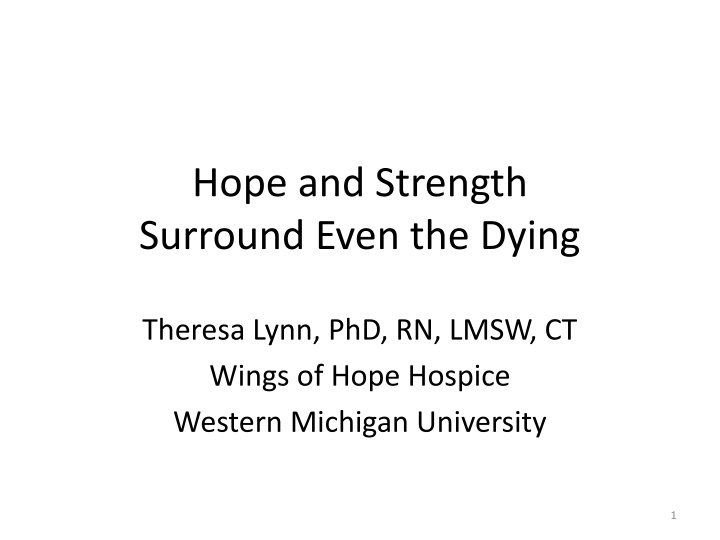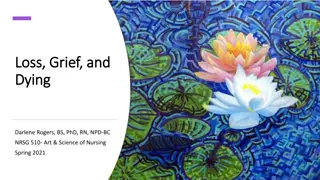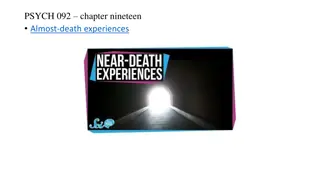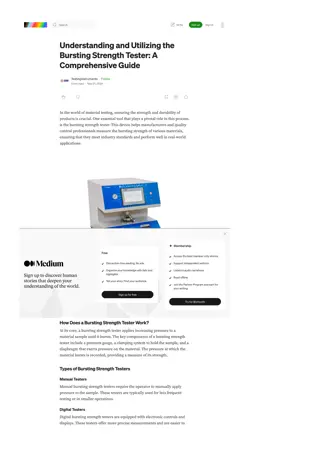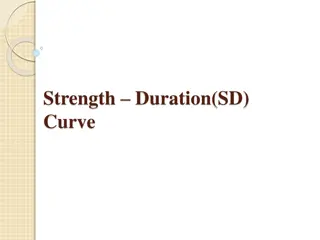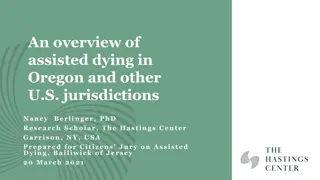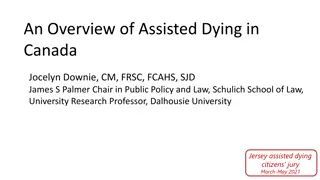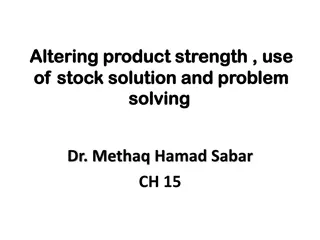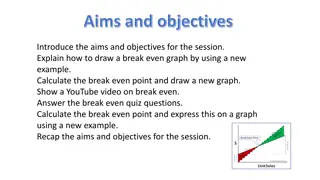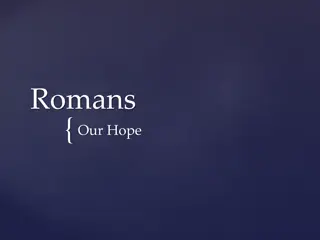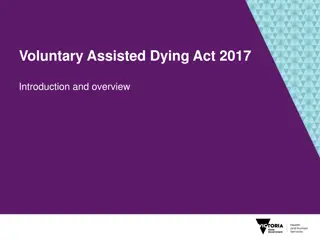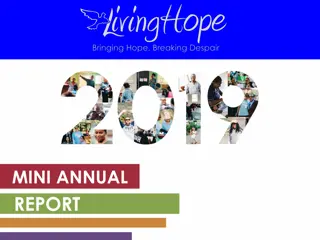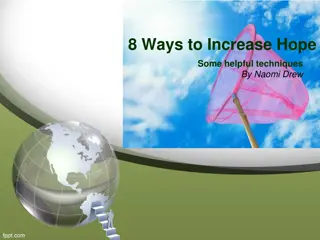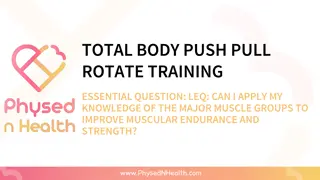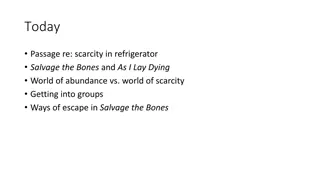Hope and Strength Surround Even the Dying
Discover the fears, hopes, and strengths of hospice patients, caregivers, and providers. Explore how these insights can enhance patient care and understanding. Delve into the importance of resilience in aging and the value of relationships at the end of life.
Download Presentation

Please find below an Image/Link to download the presentation.
The content on the website is provided AS IS for your information and personal use only. It may not be sold, licensed, or shared on other websites without obtaining consent from the author.If you encounter any issues during the download, it is possible that the publisher has removed the file from their server.
You are allowed to download the files provided on this website for personal or commercial use, subject to the condition that they are used lawfully. All files are the property of their respective owners.
The content on the website is provided AS IS for your information and personal use only. It may not be sold, licensed, or shared on other websites without obtaining consent from the author.
E N D
Presentation Transcript
Hope and Strength Surround Even the Dying Theresa Lynn, PhD, RN, LMSW, CT Wings of Hope Hospice Western Michigan University 1
Credentials PhD Interdisciplinary Health Sciences, WMU LMSW GVSU RN, BSN GVSU CT Certified Thanatologist, Association for Death Education and Counseling Executive Director, Wings of Hope Hospice Director, Wings Home Instructor, WMU online Understanding Grief & Loss 2
Dissertation Choices Related to Maximizing Quality of Life at End of Life 3
Dissertation Chapter 5 triads (hospice patient, family member, provider) were interviewed about experience of hospice referral Strong themes of hope, strength and fear emerged Fears, Hopes and Sources of Strength Expressed by Hospice Patients, Caregivers and Providers and How They Inform Care 4
2 Research Questions What are the fears, hopes, and sources of strength expressed by hospice patients, their caregivers and their referring health care providers? What can these responses inform our understanding of and the care provided to patients and their caregivers? 5
Why Important? Resilience: the Bright Side of Aging? US, 2014 84% of all patients in hospice care were 65+ years old 41% were 85+ years old1 Alive until the moment of death 6
Objectives Differentiate between the hopes, strengths and fears of hospice patients, their caregivers and their providers. Define different kinds of hope and how hope changes related to end of life. 7
Objectives (cont.) Assess the value of knowledge about hope, strength and fear and how it might inform the way providers care for individuals with life-limiting illness and their caregivers. Describe the importance of relationships related to end of life. 8
Avoidance Many providers avoid talking with individuals/families about life expectancy Inaccurate prognostication2-8 Discomfort discussing death9 Believe patient unwilling to acknowledge death10,11 Continue curative treatment12 9
Avoidance (cont.) Lack of knowledge about hospice13 Avoid perception of giving up hope14 Fear of losing control of managing illness13,15 Ignorance of culture & perception of hospice16 Perception of financial reasons15 10
Time Providers may perceive no time to have discussions about EOL Clinician is efficient at expense of patient-centered care17 11
Myth Becoming a hospice patient causes one to lose hope 12
Context Triad 1 Rachel, Liza, Dr. N. Triad 2 Paul, Lindy, NP E. Triad 3 Ken, Nina, Dr. S. Triad 4 Victor, Anya, Dr. G. Triad 5 Mark, Jenny, Dr. T. 13
Triad 1 Rachel patient, age 96 Liza daughter, lives in summer home 30 minutes south Dr. N oncologist 14
Triad 2 Paul patient, early 40s, strokes, guarded about AIDS diagnosis, rejected by family Lindy girlfriend, home in small west Michigan town NP E friendly, part of hospital system 15
Triad 3 Ken patient, age 89 Nina wife, family-oriented Dr. S pulmonologist 16
Triad 4 Victor patient, 70s, retired pastor, cancer with metastases Anya wife, champion Dr. G. oncologist 17
Triad 5 Mark patient, 70+, COPD, CHF Jenny sister, caregiver Dr. T. general practitioner 18
Objective 1 Differentiate between the hopes, strengths and fears of hospice patients, their caregivers and their providers. 19
Fear - Definition To be afraid of or to worry about 18 20
Patients Fears Rachel heart attack Paul Not knowing if I ll get up the next day Ken I just hope that when it s time to go that I don t suffer too bad Victor her being without me Mark not completing house projects, stated no longer afraid of dying 21
Caregivers Fears Not afraid promoted to glory I don t want to see him suffer when it s his time. How lonely I m gonna be I m so afraid of him not being here He helps me fix stuff. 22
Providers Concerns I want him to be able to live at home with his family and his loved ones around him and maintain as good a quality as long as he can. Patient not being realistic about abilities With hospice on board I feel the concerns are minimal. 23
Fears/Concerns of Study Participants Physical Emotional Paul day to day uncertainty Nina see patient suffer Social Spiritual Mark - unfinished projects Victor no one will see or use papers he wrote Mark dying (prior to minister s support) Rachel heart attack Paul wheelchair bound rest of life Nina loneliness Jenny managing home with patient Liza not afraid, patient promoted to glory Ken suffering Liza patient might fall, break hip Nina patient will suffer Victor wife being without him Anya of patient not being here Dr. S presence of loved ones for patient Dr. S peaceful death before death Dr. T minimal concern Dr. G patient not realistic after death Dr. S quality of life 24
Strength the ability to resist being moved or broken by a force 19 25
Strength I believe the Lord s watching over me. My family is supportive. Lord, help me be a healing influence for this person. I know how to do this work. 26
Sources of Strength Spiritual Physical Intellectual Social Mark working Dr. G - I know how to do this [work] Paul - Lindy s family Rachel the Lord Lindy - family Liza - God Victor great marriage Anya - Victor Dr. N - family Ken the Almighty Nina faith in God Victor our faith. Dr. T faith in people Anya God Almighty Jenny - God patient NP E - God Dr. S Christian faith Dr. T Christian faith caregiver provider provider 27
Objective 2 Define different kinds of hope and how hope changes related to end of life. 28
Hope to want something to happen or be true and think that it could happen or be true 20 29
Patients Hopes To go to heaven Do what I can from the wheelchair That wife will do well Man enough to take the pain Magic bullet (cure) A longer life To get things done 30
Caregivers Hopes Passing to be peaceful No suffering For the magic bullet (cure) Keep him as active as he wants to be 31
Providers Hopes Patient wishes respected Symptoms managed Family receive support 32
Hope as Trust or Reliance21 Rachel (P) go to heaven, go home Ken (P) that wife can exist after I m gone Victor (P) peaceful transition, strength for wife and kids Liza (C) patient s passing to be peaceful (D), for patient to be happy Nina (C) patient doesn t suffer Dr. N (Pr) patient s wishes are respected, family receives support Dr. S (Pr) patient will be at home with family & loved ones Dr. T (Pr) patient has sense of peace with remainder of life P - patient Before death C caregiver Death Pr - provider After death 33
Hope as Expectation of Fulfillment21 Rational Irrational Paul (P) do what I can from wheelchair Ken (P) not in a lot of pain, man enough to take it Jenny (C) keep patient comfortable Dr. N (Pr) patient s symptoms well-managed Dr. G (Pr) patient s pain well- controlled until end Liza (C) patient comfortable Victor (P) magic bullet [cure for his cancer] Anya (C) magic bullet Mark (P) longer life (get things done so caregiver doesn t have to worry) Jenny (C) patient as active as he desires before death P - patient death C - caregiver Pr - provider after death 34
Objective 3 Assess the value of knowledge about hope, strength and fear and how it might inform the way providers care for individuals with life-limiting illness and their caregivers. 35
Providers & Fears Understand to alleviate Providers difficult to anticipate post-death fears Recommend services of other disciplines 36
Providers & Strengths Social or spiritual Relationships with others/God22 Utilize relationships in care of others 37
Providers & Hope Support hopes for peaceful death by discussing care Irrational hopes not likely to change Link with resources for post- death period 38
Much Information to be Gained What are your fears? Where does your strength come from? What are your hopes? Answers can Guide treatment Understand and alleviate concerns Link with necessary resources 39
Objective 4 Describe the importance of relationships related to end of life. 40
Importance of Relationships Relationships important to most patients, caregivers and providers Don t underestimate patient-caregiver relationship Providers intentionally foster trusting relationships Establish foundation for discussions about end of life Trust can make conversations more efficient may seem paradoxical 41
Humanity as Connector Patients, caregivers and providers have unique perspectives but have humanity in common Recognition of humanity may nurture end of life discussions Still alive last opportunity to help someone maximize resilience Continued resilience living with loss Results in living more fully 42
Thank you 43
References 44
1National Hospice and Palliative Care Organization. (2015). NHPCO s facts & figures: hospice care in America. Retrieved from http://www.nhpco.org/sites/default/files/public/Statistics_R esearch/2015_Facts_Figures.pdf 2Brandt, H. E. (2006). Predicted survival vs. actual survival in terminally ill noncancer patients in dutch nursing homes. Journal of Pain and Symptom Management, 32(6), 560-566. 3Brickner, L., Scannell, K., Marquet, S., & Ackerson, L. (2004). Barriers to hospice care and referrals: Survey of physicians' knowledge, attitudes, and perceptions in a health maintenance organization. Journal of Palliative Medicine, 7(3), 411-418. 4Carrion, I. V. (2010). Communicating terminal diagnoses to Hispanic patients. Palliative Supportive Care, 8(2), 117-123. 45
5Casarett, D. J., Crowley, R. L. & Hirschman, K. B. (2004) How should clinicians describe hospice to patients and families? Journal of the American Geriatrics Society 52,(11), 1923-1928. 6Center to Advance Palliative Care (CAPC). (2014). Retrieved from http://www.capc.org 7Charon, R. (2001). Narrative medicine: A model for empathy, reflection, profession, and trust. Journal of the American Medical Association, 286(15), 1897-1902. 8Christakis, N. A., & Lamont, E. B. (2000). Extent and determinants of error in doctors' prognoses in terminally ill patients: Prospective cohort study. BMJ: British Medical Journal, 320(7233), 469-472. 46
9Wyatt, G. K., Ogle, K. S., & Given, B. A. (2000). Access to hospice: A perspective from the bereaved. Journal of Palliative Medicine, 3(4), 433-440. 10Hyman, R. B. & Bulkin. (1990). Physician reported incentives and disincentives for referring patients to hospice. The Hospice Journal, 6(4), 39-64. 11Ogle, K. (2003). Hospice and primary care physicians: Attitudes, knowledge, and barriers. The American Journal of Hospice Palliative Care, 20(1), 41-51. 12Sanders, B. S. (2004). Hospice referral decisions: The role of physicians. The American Journal of Hospice and Palliative Medicine, 21(3), 196-202. 47
13Weggel, J. M. (1999). Barriers to the physician decision to offer hospice as an option for terminal care. Wisconsin Medical Journal, May/June, 49-53. 14Kelly, K. S. (2006). Improving the way we die: A coorientation study assessing agreement/disagreement in the organization-public relationship of hospices and physicians. Journal of Health Communication, 11(6), 607- 627. 15Richards, J., & Takeuchi, L. R. (2006). Factors that influence physicians' recommendation of hospice care: An exploratory study. Journal of Hospital Marketing and Public Relations, 17(1), 3-25. 16Carrion, I. V. (2010). Communicating terminal diagnoses to hispanic patients. Palliative Supportive Care, 8(2), 117-123. 48
17McCrae, N. (2013). Person-centred care: rhetoric and reality in a public healthcare system. British Journal of Nursing, 22(19), 1125-1128. 18Merriam-Webster. (2014a). Retrieved from http://www.merriam- webster.com/dictionary/fear 19Merriam-Webster. (2014c). Retrieved from http://merriam-webster.com/dictionary/strength 20Merriam-Webster. (2014b). Retrieved from http://www.merriam- webstercom/dictinoary/hope 49
21Tulsky, J. A. (2002). Hope and hubris. Journal of Palliative Medicine, 5(3), 339-341. 22Smits, H. L., Furletti, M., & Vladeck, B. C. (n.d.). Palliative care: An opportunity for Medicare. Institute for Medicare Practice, Mount Sinai School of Medicine. Retrieved from http://www.mssm.edu/instituedformedicare/ 50
